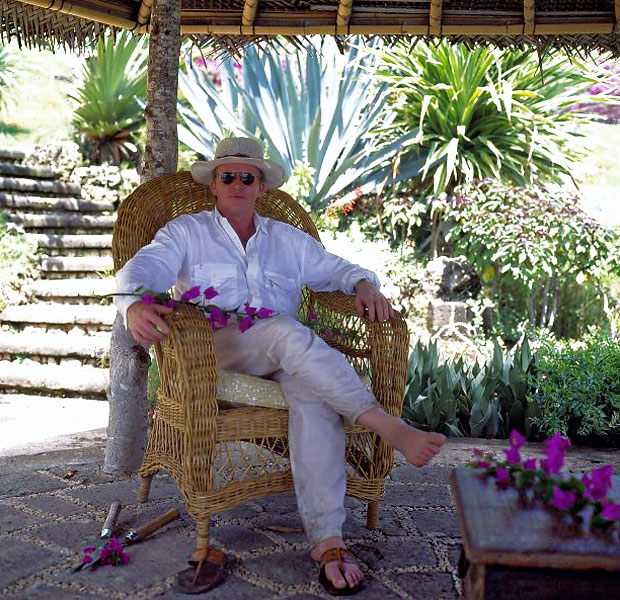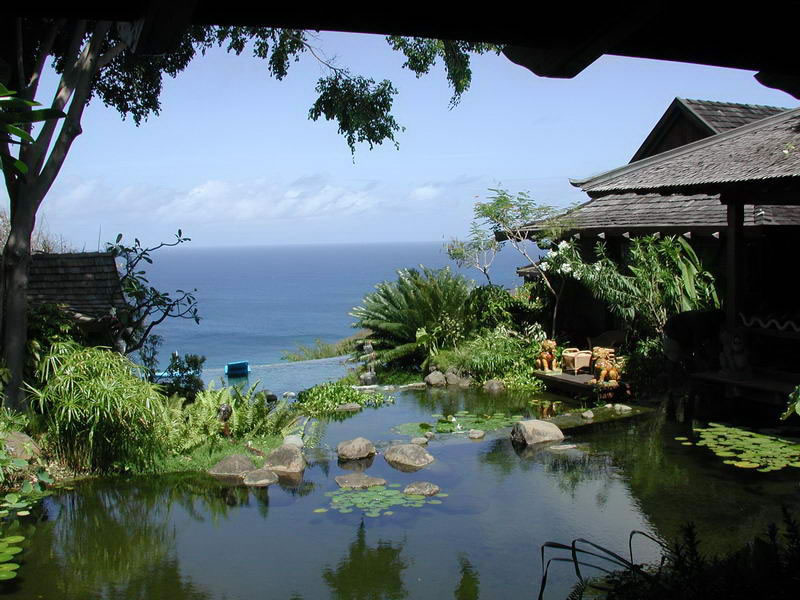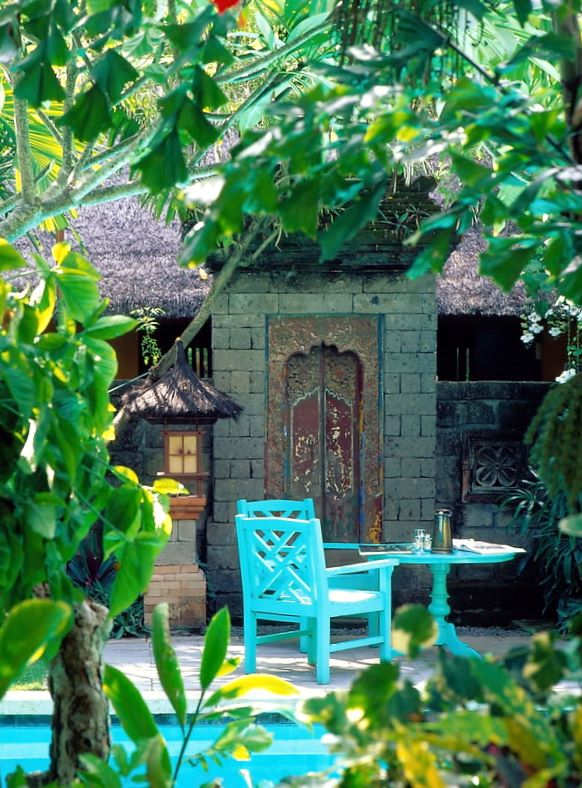
David Bowie's Mustique garden and other tales
Gardener's Garden designer Made Wijaya on working with the Thin White Duke, why 'anal architects' are ruining landscape gardening, his love of Bali and why he thinks the current craze for zen gardens is a bit 'tragic'
Made Wijaya’s style of tropical gardening has been characterised as ‘the tropical Cotswolds look’. It's an apt description for a garden designer and Gardener's Garden contributor who grew up in a cottage in the Syndey suburbs, with a typically English garden overseen by his mother, who has since made his name in Indonesia, taking the flora of the tropics and introducing it to an artful, near-rustic European sensibility. Yet this cosy description perhaps underplays Made's deep understanding of South Asian history, culture, and botany. While his style might not appeal to fans of Zen-style minimalism, Made has attracted his fair share of fashionable clients, including David Bowie and Francis Ford Coppola. Read on to discover how this teenage tennis coach became one of the world’s leading tropical garden designers.
Tell us about your early life, before coming to Indonesia. I grew up in Bondi, in Sydney’s eastern suburbs. There’s a very beautiful botanical garden next to the opera house. My mother was a gardener, and I knew I wanted become an artist, so I studied architecture for want of anything else to do.
You were a teenage tennis champ too. Has that helped your career? When I was sixteen I was number one in the state and I won the Australian Young Masters. But then I discovered marijuana at university and that was it. Still, the sport helped me wield a scythe, which is the implement of choice in South Asia, and it also helped me when dealing with clients. I was a bit like Lleyton Hewitt, and having a competitive personality has served me well.
How did you end up in Bali? I sailed there with some mates, and became a hippy. I worked as a tennis coach, made films, and took up photojournalism. Then the wife of a famous architect suggested I try garden design. The very first garden I worked on was by the great Sri Lankan architect, Geoffrey Bawa.
You were born Michael White, but you now go by the Indonesian name of Made Wijaya. How did that come about? It was my nom de plume for this column I write, Stranger in Paradise, and it stuck. No one knows me as Michael White. I’m not a card-carrying Hindu. It was just a nom de plume that stuck.
What was your first big commission? I was lucky to get my teeth into the Bali Hyatt’s garden in Sanur, the old tourist region. That was in 1979. There was a lovely English general manager at the hotel. I said “I’d like fifty gardeners and I’d love free breakfasts for six months.” It started from there. I got a reputation for being cheap.
You also maintain your own group of Balinese gardeners, or ‘commandos’ as you put it. Yes. I had some friends from a traditional village near Sanur and I employed some of them. The Balinese are great gardeners; very athletic, and nature lovers. I always thought handing over a wad of drawings to a project manager was not how you get a great garden. So, I take these guys with me whenever it's cost efficient, and it generally is, because labour is cheap in South Asia.
You really do have to have cheap labour to have great gardens? I think so. Look at the great gardens in Los Angeles; there’s plenty of Mexican labour there; and it’s true throughout the ages. Many great gardens were created by slaves.
Tell us about your own garden, Villa Bebek, which is featured in The Gardener’s Garden. It was a place I designed for an Australian friend. She wanted a house and a guest cottage, and I convinced her to turn it into four courtyards, and I became a partner. Eventually she let me buy the houses back, in easy installments, so I got a place above my wealth factor. It’s a sort of art factory too. I can try out all the tricks there too.
You oversaw David Bowie’s garden in Mustique, didn’t you? Yes, everyone asks about that, though it has since been destroyed by the subsequent owner [the legendary, recently deceased British publisher] Felix Dennis. He was a bit famous for his Philistine behaviour. It was in a beautiful location on the island, above Britannia Bay. We did it back in the late eighties, before the yuppiefication of Mustique. The architect was Arne Hasselquist, an old Swedish hippy who'd worked with [English high-society artist and designer] Oliver Messel; the interiors were by Linda Garland. I brought over four of my Bali commandos and stayed at [Mustique’s famous] Basil’s bar. The happy hour got earlier and earlier, and there was nothing but clouds of marijuana on the building site from day one.

What sort of garden did you install for Bowie? Mustique is actually quite arid – not that tropical – and it’s hard to get work done there, because everyone is lazy. By fortune, this wave of statues, or actually funerary markers, from east Indonesia had started coming onto the market in Bali. I got to pick up the best of them, because I had a decent budget. I added them to this salt-tolerant, arid-tolerant garden, around these pools. Inside the house it’s a blaze of Victorian exotica. It really was very special. Then Felix came along, ripped it out, and installed an air-conditioned games parlour. He got some shop dresser from Harrods to do the interiors, and then actually went over to Bali and bought all this mindless crap. It was one of my only great gardens that has been destroyed. I have been back there and it really was depressing.
What's fashionable at the moment in garden design? Tragically, it’s all gone Zen. The Singapore faculty of architecture is very influential; they invented this ‘New Asian’ style. It’s all very minimal and formulaic. There’s lots of brown things evenly spaced in a line, often overseen by architects.
Do architects make bad gardeners? Yes! As a rule they make overly structured gardens and the hardscape is too severe. The Americans in particular have ghastly hardscape, with parallel lines like mini train sets. The English like it a bit more rustic. However, the rustic movement is very unfashionable. It's all gone soulless, treeless, birdless and loveless. You have the opportunity in the tropics to have the birds nesting around the pool and frangipani flowers dropping into the waters, but these pleasures are denied because of a school of anal architects.

What do you make of the American born, Thai-based garden designer, Bill Bensley? Is he a friend of yours? No! He's my mortal enemy. We are like Bette Davis and Joan Crawford. But he's a brilliant landscaper, just one with too many bells and whistles for my taste.
How about fellow Gardener’s Garden contributor, Madison Cox? I like him a lot. I met him in Morocco in the summer. He had done a little job for the American Legation in Tangier. I had dinner with him, then saw the work he had done. It was a small thing; he had just added this rough brick border and a few beachy pebbles. But when I saw it, I was immediately an admirer, while the previous night I had just been jealous, because he had worked on the Majorelle Garden and all these other great jobs.
What are the great jobs all garden designers go after? Well, towards the end of your career you go for public gardens and botanical gardens; they’re an honour to do. It’s also great to be invited onto the lecture circuit. I was asked to do lectures at Imperial College in London, and I’ve also done the Asian Gardens at Naples Botanic Gardens , Florida.
And what do you look for in a client? You want a brief, for the practical information. Then the ideal client is someone used to working with professionals. If he appoints you as a design consultant, he should let you consult. It also helps if they’ve got good taste. But I think the best gardens are the ones where people have people have had a good time making it. I still like the English garden style too; that's artful natural.
You can also find out more about Made's garden and many others in our beautiful new book The Gardener's Garden which you can read more about here.